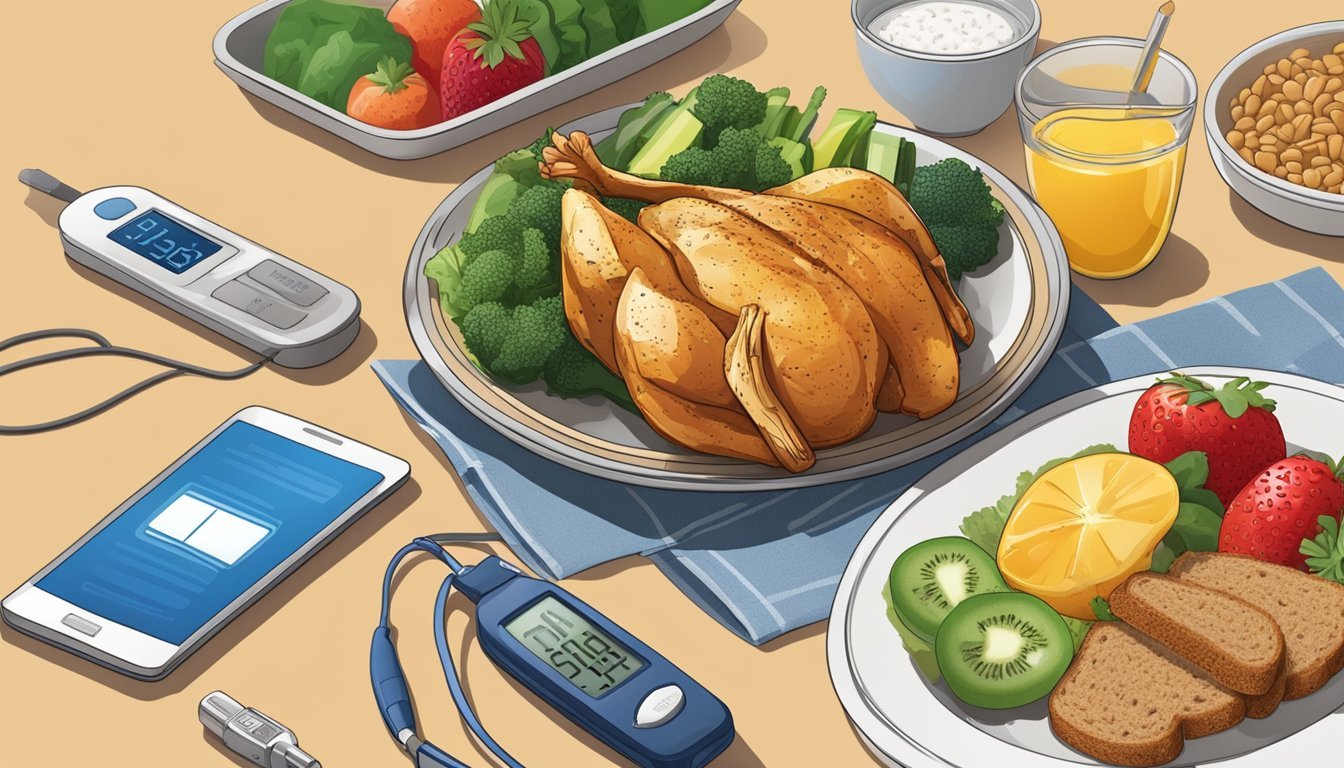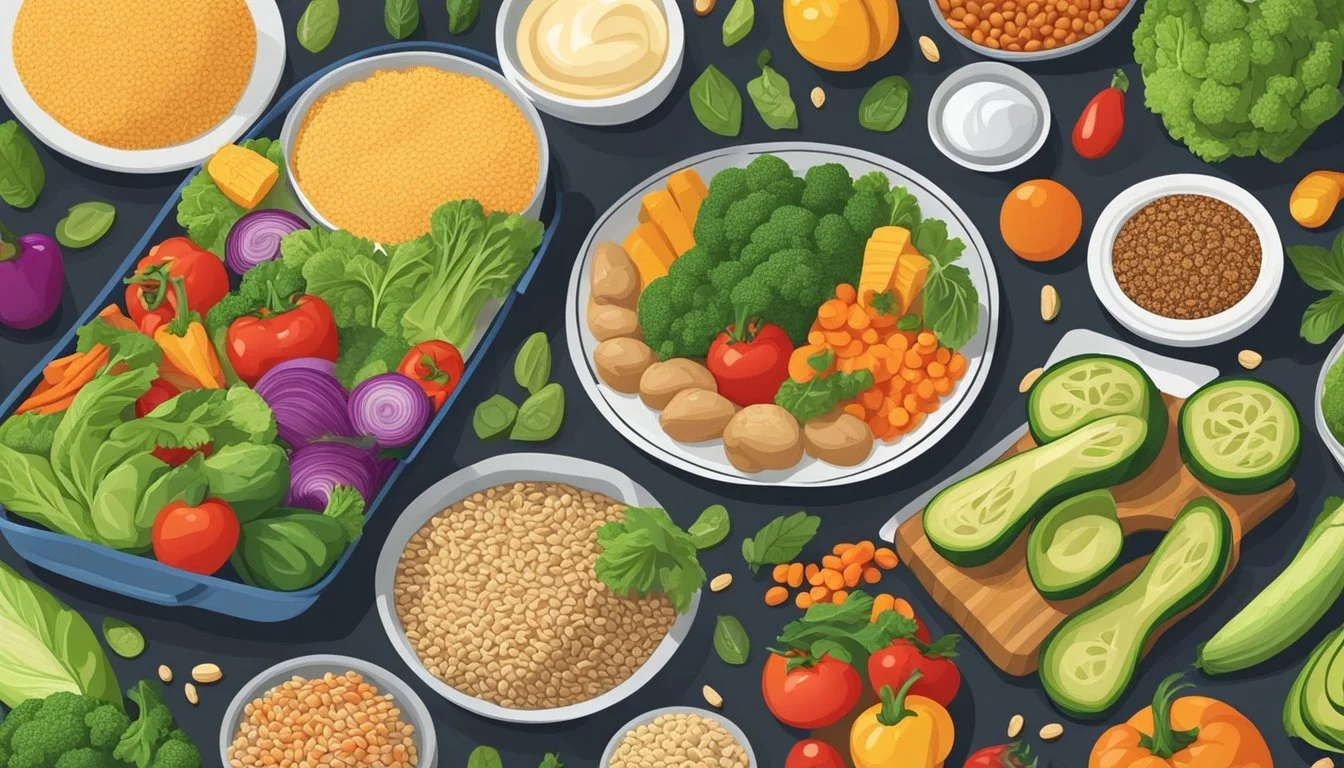Delicious Diabetes-Friendly Lunch Ideas for the UK Diet
Diabetes-friendly lunches can be both delicious and nutritious. For those living with diabetes in the UK, planning meals that help manage blood sugar levels is essential. A well-balanced lunch should include a mix of lean proteins, complex carbohydrates, and plenty of vegetables to provide sustained energy and minimize glucose spikes.
Diabetes UK recommends several easy options for healthy lunches. Open sandwiches using half the usual amount of bread can reduce calorie and carbohydrate intake. Wraps, bagels, and sandwiches can be bulked up with salad vegetables for added nutrition and fiber. Including a variety of foods like chicken or tuna salad, small pasta portions, or soup with a wholegrain roll can keep meals interesting and satisfying.
For those seeking low-carb alternatives, options such as salmon or tuna steak with salad provide protein and healthy fats without excessive carbohydrates. Adding a small piece of fruit or a pot of unsweetened yogurt can round out the meal with additional nutrients. By incorporating these ideas, individuals with diabetes can enjoy tasty lunches while maintaining stable blood sugar levels.
Understanding Diabetes and Nutrition
Diabetes is a condition that affects how the body processes glucose, impacting blood sugar levels. For people with diabetes, especially type 2 diabetes, managing diet is crucial for maintaining stable blood sugar levels.
Carbohydrates have the most significant effect on blood glucose. They break down into sugar and require insulin for proper utilization. Balancing carbohydrate intake helps control blood sugar levels effectively.
Protein and fat also play important roles in a diabetic diet. Protein aids in feeling full and supports muscle health. Fat slows digestion, which can help prevent rapid spikes in blood sugar.
Fibre is beneficial for people with diabetes. It slows digestion, improving blood sugar control and promoting feelings of fullness. High-fibre foods include vegetables, whole grains, and legumes.
A balanced diabetic diet typically includes:
Complex carbohydrates
Lean proteins
Healthy fats
High-fibre foods
Limited added sugars
Portion control is essential. Eating regular, balanced meals helps maintain steady blood sugar levels throughout the day. Monitoring carbohydrate intake and pairing it with protein and fat can further support blood glucose management.
Essential Components of a Diabetes-Friendly Lunch
A well-balanced diabetes-friendly lunch incorporates several key elements. Carbohydrates play a crucial role, but portion control is essential. Opt for complex carbs like whole grains, which provide steady energy and help manage blood sugar levels.
Protein is another vital component. Lean meats, fish, eggs, or plant-based options like legumes and tofu are excellent choices. Protein helps maintain muscle mass and promotes satiety, reducing the likelihood of overeating.
Include a variety of colorful vegetables in your lunch. They're low in calories, high in fiber, and packed with essential vitamins and minerals. Aim for at least half your plate to consist of non-starchy vegetables.
Healthy fats are important for hormone balance and nutrient absorption. Add small amounts of avocado, nuts, seeds, or olive oil to your meal.
Fiber-rich foods aid digestion and help regulate blood sugar. Incorporate foods like leafy greens, berries, and legumes into your lunch.
Here's a simple formula for a balanced diabetes-friendly lunch:
1/4 plate: lean protein
1/4 plate: complex carbohydrates
1/2 plate: non-starchy vegetables
Small serving of healthy fats
Optional: small portion of fruit
Remember to stay hydrated by choosing water or unsweetened beverages with your meal.
Balanced Lunch Ideas for Blood Sugar Management
Creating nutritious lunches is crucial for managing diabetes effectively. Balanced meals help stabilize blood sugar levels and provide sustained energy throughout the day.
Whole grains form an excellent base for diabetic-friendly lunches. Brown rice and quinoa are nutrient-dense options that offer fiber and complex carbohydrates. These grains can be paired with lean proteins and vegetables for a well-rounded meal.
Beans are another valuable addition to diabetic lunches. They're rich in fiber and protein, which aids in blood sugar regulation. A bean salad with mixed vegetables and a light vinaigrette dressing makes for a satisfying and healthy option.
Here are some quick and easy lunch ideas:
Open-faced sandwich on whole grain bread with turkey, avocado, and mixed greens
Quinoa bowl with grilled chicken, roasted vegetables, and a sprinkle of nuts
Greek yogurt parfait with berries, chia seeds, and a handful of granola
Lentil soup with a side of whole grain crackers and cheese
Including nuts in lunches provides healthy fats and protein. A small portion can help curb hunger and maintain stable blood sugar levels.
Remember to balance carbohydrates, proteins, and fats in each meal. This approach helps manage blood sugar, blood pressure, and cholesterol levels effectively.
Lean Proteins and Healthy Fats
Incorporating lean proteins and healthy fats into your diabetes-friendly lunch is crucial for managing blood sugar levels and maintaining energy throughout the day. These nutrient-dense options provide essential building blocks for the body while supporting overall health.
Lean Meat Choices for Lunch
Chicken breast is an excellent lean protein choice for diabetic lunches. It's low in fat and can be prepared in various ways. Grilled or baked chicken slices work well in sandwiches or salads.
Tuna is another versatile option, rich in omega-3 fatty acids. Canned tuna in water can be mixed with light mayonnaise or Greek yogurt for a protein-packed sandwich filling.
Salmon, whether fresh or canned, offers both lean protein and healthy fats. It can be served cold in a salad or as part of a wrap with vegetables.
Lean beef or pork can be included in moderation. Choose cuts like sirloin or tenderloin for lower fat content. These meats can be sliced thinly for sandwiches or added to salads for a satisfying lunch.
Incorporating Healthy Fats Into Your Lunch
Olive oil is a heart-healthy fat that can be used in dressings or for cooking. Drizzle it over salads or use it to sauté vegetables for a nutrient boost.
Avocado is packed with monounsaturated fats and fiber. Mash it onto whole-grain toast or add slices to sandwiches and salads for creamy texture and flavor.
Nuts like almonds, walnuts, and pistachios provide healthy fats and protein. Sprinkle a small handful over salads or yogurt for added crunch and nutrition.
Seeds such as pumpkin or sunflower seeds are rich in healthy fats and minerals. They make great toppings for salads or can be included in homemade trail mix for a quick snack.
Vegetable-Based Lunch Options
Vegetables form the cornerstone of nutritious, diabetes-friendly lunches. These options provide essential nutrients and fiber while helping maintain stable blood sugar levels.
Salads and Wraps
Mixed green salads offer endless possibilities for diabetes-friendly lunches. Start with a base of spinach, lettuce, or kale. Add colorful vegetables like tomatoes, cucumbers, and bell peppers. For protein, include grilled chicken, tuna, or hard-boiled eggs.
Chickpeas or kidney beans make excellent plant-based protein additions. Dress the salad with a light vinaigrette or lemon juice to keep calories in check.
Wraps provide a portable lunch option. Use whole wheat tortillas filled with hummus, sliced vegetables, and lean protein. Sprinkle with herbs for extra flavor.
Greek-inspired wraps with feta cheese, olives, and cucumber offer a Mediterranean twist. Roll tightly and slice for easy eating.
Hearty Soups and Stews
Vegetable-based soups and stews make satisfying lunches for cooler days. Tomato-based soups packed with mixed vegetables provide a warming meal rich in nutrients.
Lentil soup offers a protein-packed option that's easy to prepare in advance. Add carrots, celery, and onions for extra flavor and nutrition.
Bean soups, such as minestrone or black bean soup, provide fiber and protein to help stabilize blood sugar levels. Include a variety of vegetables like zucchini, green beans, and spinach.
For a creamy option without excess fat, try butternut squash or carrot soup blended with low-fat milk or vegetable broth. Serve with a small whole grain roll for a complete meal.
Low-Carb Alternatives and Substitutions
Reducing carbohydrate intake can help manage blood sugar levels for individuals with diabetes. Traditional high-carb foods like pasta, rice, bread, and potatoes can be replaced with lower-carb options.
Instead of regular pasta, try zucchini noodles or shirataki noodles. These alternatives provide a similar texture with significantly fewer carbohydrates.
For rice substitutes, consider cauliflower rice or konjac rice. These options mimic the texture of rice while keeping carb content low.
Bread alternatives include:
Lettuce wraps
Cloud bread (made from eggs and cream cheese)
Flaxseed bread
Potato substitutes can include:
Mashed cauliflower
Turnip fries
Radish hash browns
When choosing grains, opt for lower glycemic index options like quinoa or bulgur wheat. These provide more fiber and nutrients while having less impact on blood sugar.
For those who still prefer traditional carbs, portion control is key. Choosing whole grain versions and pairing them with protein and healthy fats can help moderate blood sugar spikes.
Remember to monitor blood glucose levels when trying new foods to understand their individual impact on blood sugar.
Creative Lunch Recipes for Home or Work
Diabetes-friendly lunches can be both delicious and convenient. These recipes cater to busy lifestyles while helping maintain stable blood sugar levels.
Simple and Quick Recipes
Chicken and veggie wrap: Mix diced grilled chicken with cucumber, tomatoes, and leafy greens. Spread a thin layer of hummus on a whole-grain wrap and roll up the ingredients.
Tuna salad stuffed peppers: Combine canned tuna with diced celery, red onion, and a dollop of Greek yogurt. Stuff the mixture into halved bell peppers for a low-carb option.
Egg and avocado toast: Mash avocado onto whole-grain toast and top with sliced hard-boiled eggs. Sprinkle with salt, pepper, and a dash of paprika for extra flavor.
Greek yogurt parfait: Layer Greek yogurt with berries, chopped nuts, and a sprinkle of cinnamon. This protein-packed lunch is both satisfying and diabetes-friendly.
Make-Ahead Meals
Mason jar salads: Layer ingredients like grilled chicken, mixed greens, cherry tomatoes, and cucumber in a jar. Keep dressing separate until ready to eat.
Quinoa vegetable bowls: Cook quinoa and mix with roasted vegetables like broccoli, carrots, and zucchini. Add grilled chicken or tofu for protein. Portion into containers for easy grab-and-go lunches.
Lentil soup: Prepare a batch of lentil soup with vegetables and lean protein. Freeze individual portions for quick reheating at work.
Bento boxes: Fill compartments with hard-boiled eggs, cheese cubes, vegetable sticks, and whole-grain crackers. These balanced meals are perfect for portion control.
Strategies for Dining Out With Diabetes
Dining out with diabetes requires thoughtful planning and smart choices. Selecting restaurants that offer healthier options can make managing blood sugar levels easier.
Before leaving home, check the menu online to identify suitable dishes. This allows time to plan insulin doses if needed. Timing meals to align with regular eating schedules helps maintain consistent blood sugar.
At the restaurant, don't hesitate to ask how dishes are prepared. Request modifications like grilled instead of fried foods, or sauces on the side. Opt for lean proteins, vegetables, and whole grains when available.
Portion control is key. Consider sharing a main course or taking half home for later. Start with a broth-based soup or salad to help curb appetite.
Be mindful of hidden carbohydrates in sauces, dressings, and beverages. Choose water, unsweetened tea, or diet drinks instead of sugary options.
For those using insulin, discuss adjusting doses with a healthcare team to accommodate dining out. This flexibility can allow for occasional treats while maintaining blood sugar control.
Remember to pack glucose tablets or a quick-acting carbohydrate snack in case of unexpected low blood sugar. With these strategies, people with diabetes can enjoy dining out while managing their health effectively.
Sweet Treats and Snacks Without the Sugar Spike
Managing blood sugar levels doesn't mean giving up on tasty treats. There are numerous options for satisfying sweet cravings without causing glucose spikes.
Dark chocolate with a high cocoa content (70% or more) can be a good choice. It contains less sugar than milk chocolate and offers potential health benefits.
Berries are naturally sweet and packed with antioxidants. Blueberries, strawberries, and raspberries make excellent low-sugar snacks.
Nuts provide a satisfying crunch and healthy fats. Almonds, walnuts, and pecans are popular choices for people with diabetes.
Greek yogurt with a sprinkle of cinnamon can serve as a creamy, protein-rich treat. The cinnamon may help improve insulin sensitivity.
Apples with a tablespoon of peanut butter offer a balance of natural sweetness, fiber, and protein.
Roasted chickpeas seasoned with cinnamon or cocoa powder can satisfy both sweet and savory cravings.
For a refreshing option, try frozen grapes. They provide a burst of sweetness without added sugars.
When shopping for packaged snacks, look for labels that say "no added sugar" or "sugar-free." Always check the nutritional information to ensure they fit within your dietary plan.
Remember to consume all treats in moderation, even those considered diabetes-friendly. Portion control remains key in managing blood glucose levels.
Advice from Healthcare Professionals
Dietitians recommend planning balanced meals to manage diabetes effectively. They suggest including a variety of foods from different food groups in each meal.
Doctors emphasize the importance of monitoring blood sugar levels regularly. This helps patients understand how different foods affect their glucose levels and adjust their diet accordingly.
Healthcare teams often advise patients to be more active. Regular physical activity can help improve insulin sensitivity and manage weight.
Nutrition advice from experts often includes tips for portion control. Using smaller plates and measuring servings can aid in weight management for those aiming to lose excess pounds.
Professionals stress the importance of individualized meal plans. What works for one person may not work for another, so personalized advice is crucial.
Health tips from diabetes specialists often include:
Choosing whole grains over refined carbohydrates
Incorporating lean proteins in meals
Adding more vegetables to the diet
Limiting processed and high-sugar foods
Experts recommend consulting with a healthcare team before making significant changes to one's diet or exercise routine. This ensures that any new plan aligns with individual health needs and medication regimens.












